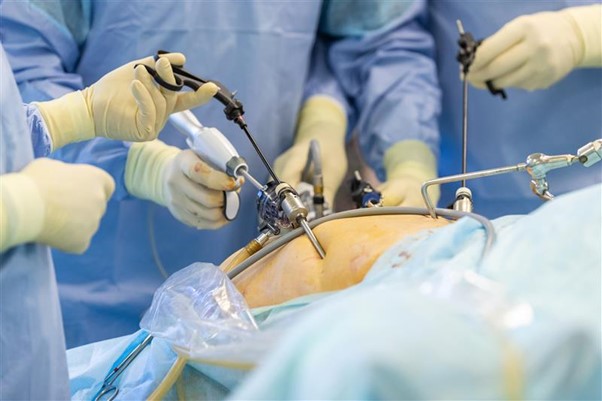A hysterectomy is a surgical procedure where the uterus is removed. While this surgery is often needed for various health reasons, there is a modern method called laparoscopic hysterectomy that is less invasive and comes with many benefits over traditional surgery.
What is a Laparoscopic Hysterectomy?
A laparoscopic hysterectomy is a type of surgery where the uterus is removed using small incisions in the abdomen, rather than the large cut required in traditional open surgery. The procedure uses a small camera (called a laparoscope) and tiny instruments inserted through the incisions to remove the uterus. Because of the small incisions, it’s considered a minimally invasive procedure, meaning there’s less pain and a faster recovery.
Why Do People Need a Laparoscopic Hysterectomy?
A laparoscopic hysterectomy may be recommended if you are dealing with certain medical conditions related to the uterus. Some common reasons include:
- Uterine Fibroids: These are non-cancerous growths in the uterus that can cause heavy bleeding, pelvic pain, or pressure.
- Endometriosis: A condition where tissue that normally lines the inside of the uterus grows outside, causing pain, heavy bleeding, and sometimes fertility problems.
- Pelvic Pain: If you have long-term pelvic pain that doesn’t go away with other treatments, a hysterectomy may be considered.
- Uterine Cancer: In cases of cancer of the uterus or cervix, removing the uterus might be necessary.
- Uterine Prolapse: This occurs when the uterus drops into the vaginal canal due to weakened pelvic muscles.
- Heavy or Irregular Bleeding: If bleeding is extremely heavy or irregular and other treatments haven’t worked, a hysterectomy may be an option.
Benefits of Laparoscopic Hysterectomy
There are several benefits of choosing laparoscopic hysterectomy over traditional open surgery:
- Smaller Incisions: The key advantage of laparoscopic surgery is that it requires only small incisions—usually around 1 to 2 cm. This means less trauma to your body, reduced pain, and a quicker recovery.
- Faster Recovery: Because the surgery is minimally invasive, most women recover more quickly. You may be able to return to normal activities in about 2 to 4 weeks, compared to 6 to 8 weeks after open surgery.
- Less Pain: Since the incisions are smaller, the pain after surgery is usually much less, and you might need fewer pain medications.
- Reduced Risk of Infection: Smaller incisions mean less risk of infections, which helps you heal faster and with fewer complications.
- Less Scarring: The small incisions made for laparoscopic surgery leave smaller scars, which are less noticeable than the scars from traditional open surgery.
- Quicker Return to Work: Most women can return to work and regular daily activities much sooner after laparoscopic surgery compared to traditional surgery.
What Happens During the Surgery?
Laparoscopic hysterectomy is usually performed under general anesthesia, which means you’ll be asleep during the procedure. Here’s an overview of what happens:
- Preparation: Before the surgery, you’ll meet with your doctor to discuss the procedure, your medical history, and any medications you’re taking. You’ll also be given instructions on how to prepare for the surgery, like fasting for a few hours beforehand.
- Making Small Incisions: Once you’re asleep, the surgeon will make a few small incisions, usually around your belly button and lower abdomen. Through one of these incisions, the surgeon will insert the laparoscope, which is a small tube with a light and camera to help them see inside your body.
- Removing the Uterus: Using special instruments, the surgeon will remove the uterus. Sometimes, the uterus is cut into smaller pieces to make it easier to remove through the small incisions.
- Closing the Incisions: After the uterus is removed, the surgeon will close the small incisions with stitches or surgical glue. The surgery usually takes about 1 to 3 hours.
- Recovery Time: Most women can go home the same day or the next day after the surgery, but in some cases, an overnight stay might be required.
What is Recovery Like After a Laparoscopic Hysterectomy?
One of the main advantages of laparoscopic hysterectomy is the shorter recovery time. However, it’s important to follow your doctor’s advice to ensure a smooth recovery. Here’s what to expect:
- Hospital Stay: In most cases, you will go home on the same day or the following day after surgery. If needed, you may stay overnight for observation.
- Pain Management: You may experience some discomfort, but this can usually be managed with pain relievers. Your doctor will advise on what medications to take.
- Physical Activity: For the first few weeks, you should avoid heavy lifting, strenuous exercise, and sexual activity to allow your body to heal properly.
- Follow-Up Appointments: You will have follow-up appointments with your doctor to monitor your recovery and check for any complications.
- Return to Normal Activities: Most women can return to work and normal activities within 2 to 4 weeks after the surgery. However, it may take longer to resume more demanding physical activities.
What Are the Risks of Laparoscopic Hysterectomy?
While laparoscopic hysterectomy is generally safe, there are some risks, including:
- Infection: Though rare, infections can occur at the incision sites or internally.
- Bleeding: There may be some bleeding during or after the surgery, but excessive bleeding is uncommon.
- Injury to Surrounding Organs: There’s a small risk that nearby organs, like the bladder or bowel, could be accidentally injured during the surgery.
- Blood Clots: In rare cases, blood clots can form in the legs or lungs after surgery, so it’s important to move around as directed by your doctor to prevent this.
- Anesthesia Risks: Any surgery involving anesthesia carries small risks, but these are usually minimal with proper medical care.
A laparoscopic hysterectomy is a modern, minimally invasive surgery that can help women dealing with a variety of uterine health issues. It offers many advantages over traditional open surgery, such as smaller incisions, less pain, and a faster recovery. If you’ve been advised to have a hysterectomy, it’s important to discuss your options with your doctor to determine if laparoscopic surgery is the right choice for you.



